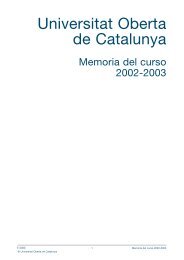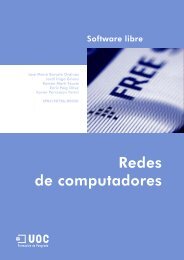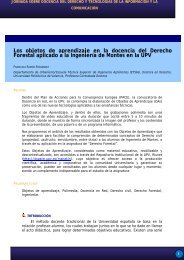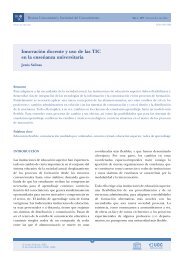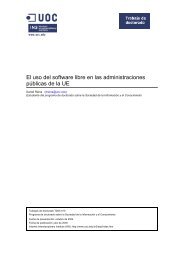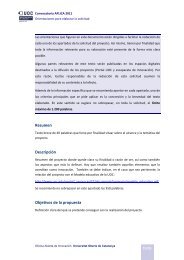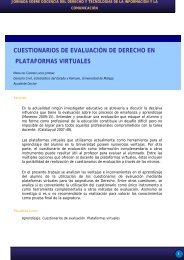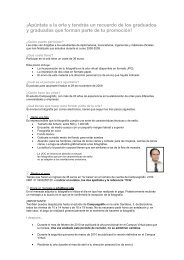e-governance and citizen information - Universitat Oberta de ...
e-governance and citizen information - Universitat Oberta de ...
e-governance and citizen information - Universitat Oberta de ...
Create successful ePaper yourself
Turn your PDF publications into a flip-book with our unique Google optimized e-Paper software.
E-<strong>governance</strong> <strong>and</strong> Citizen Information 36 Theoretical Framework. The Network AdministrationAll in all, <strong>governance</strong> introduces a new focus that can be used to observe the changes in thearticulation of power, incorporating the supranational, regional <strong>and</strong> local government levels, includingthe private sector <strong>and</strong> civil society. The analysis of government does not try to reject aperspective focused on the Administration; on the contrary, it aims to incorporate new elementsthat interact in the management of the public space. In this sense, as stated by Peters <strong>and</strong> Pierre(2005), the concept appears to have been created to <strong>de</strong>pict an effective change in society as ananalytical tool generated by social scientists for the improvement of the quality of prior analyses.In addition, as mentioned above, the newly created New Public Management (NPM), has alsohad a relevant role in the questioning of the traditional Public Administration <strong>and</strong> a significant influenceon the <strong>de</strong>sign of policies for the administrative reform, especially in the Anglo-Saxonworld.2.3.6. Governance <strong>and</strong> New Public ManagementEven though the theories of <strong>governance</strong> have ten<strong>de</strong>d to be contrasted with New Public Management,we can state that the former is a political theory while the latter is an administrativetheory (Ewalt, 2001). Peters <strong>and</strong> Pierre (1999) states that the coinci<strong>de</strong>nce between both theorieslies in the emphasis on the dissolution of the limits between the public <strong>and</strong> private sectors.NPM is orientated on results, while <strong>governance</strong> analyses the processes <strong>and</strong> in somecases the resources employed to provi<strong>de</strong> balance to a system that acts with greater autonomy.There is agreement on the need to incorporate new actors to public management activities,partly to support the provision of services, <strong>de</strong>spite the tax <strong>de</strong>ficit <strong>and</strong> <strong>de</strong>cline of the “producer”role previously held by the state (Pierre <strong>and</strong> Peters, 2001). In this sense, the ICT industry isconsolidated as the dominant competition of the private sector which will then become the provi<strong>de</strong>rof the public sector.Despite these basic agreements, some authors indicate that there is a danger of some services<strong>and</strong> systems being privatised, e.g. to avoid internal difficulties in the governmental integrationof back office functions (Dunleavy <strong>and</strong> Margetts, 2000). Fountain (2005) arguesthat privatisation in the e-government sphere can be an error because the negotiations tointroduce technology inclu<strong>de</strong> negotiations that require a learning <strong>and</strong> cultural adaptationprocess. At this point, the problems appear in the mutual reinforcement of various elements.The fragmentation <strong>and</strong> autonomy of <strong>de</strong>partments, in addition to the outsourcing of IT services– as required for each <strong>de</strong>partment to follow a different strategy in the incorporation <strong>and</strong>use of ICTs – would generate excessively differentiated contexts.http://www.uoc.edu/in3/pic




